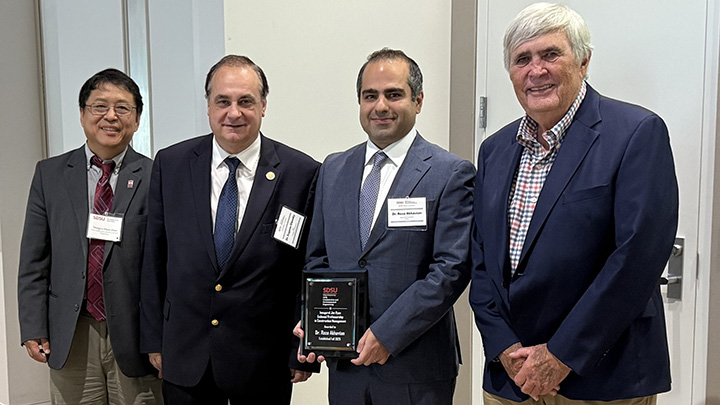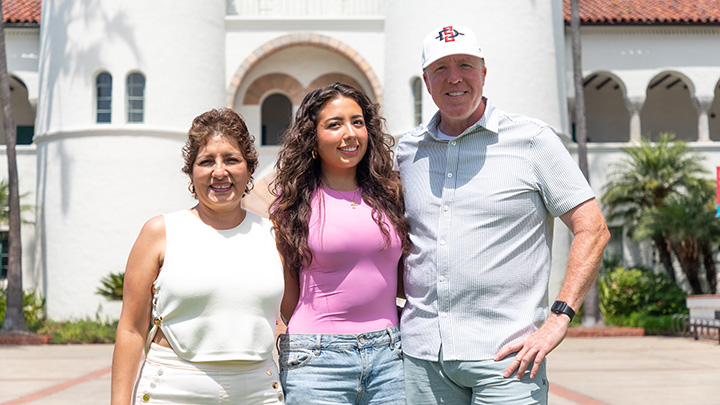Eugene Olevsky: Engineering Higher Aspirations
The Ukraine native has made a mark after two years as dean of one of SDSUs most innovative colleges, setting the bar high for its faculty and students.

College of Engineering Dean Eugene Olevsky was featured in the most recent episode of Fireside Charla, highlighting engineering research at the university, along with two research faculty.
When faced with a problem, Eugene Olevsky learned at an early age to stick with it until he found a solution, which often meant creative workarounds to achieve the goal. He has applied this throughout his career as a researcher and now as dean of the College of Engineering at San Diego State University.
Olevsky has been dean since 2018, and also runs the SDSU Powder Technology Lab, with seven graduate and doctoral students. Among his achievements: $22 million in research funding over his career and more than 500 scientific publications.
As dean, Olevsky is focused on college growth, recruiting more diverse students and faculty, and attracting top notch researchers. He approaches every roadblock with characteristic determination and elan.
Creative problem solving
Growing up in Iron Curtain-era Kiev, Ukraine, Olevsky excelled as a student and was his high school’s valedictorian.
“I always wanted to be a scientist and professor,” he said.
His dream of pursuing a pure math education ran into a brick wall when the university offered him mechanical engineering instead, a much less popular major at that time, because of concerns that he would emigrate to the U.S with his valuable training.
His mother offered a disappointed Olevsky an unusual solution. Why not pursue a simultaneous second degree in math elsewhere? To do that, he would need a second GED since his high school diploma could only be submitted once. His mother encouraged him to take on the challenge.
So 18 year-old Olevsky actually did it — he went to college for mechanical engineering while getting his second GED from a night school, which allowed him to pursue a second degree in math, graduating from two universities with two different degrees simultaneously.
“The most difficult time was when both universities had finals at the same time,” Olevsky recalled. “I would finish the finals at one place, then catch a cab to the second college to complete another set of finals.”
Mentor who set the course
Armed with a 5.0 GPA, he joined the Ukraine National Academy of Sciences as a research engineer and learned of legendary scientist Valery Skorohod, a pioneer in the field of sintering. Sintering is the process of consolidating powder material at high temperatures, which have a wide variety of uses from manufacturing engine parts to bone replacement.
He managed to get in to see him but froze from nervousness. However, his two summa cum laude diplomas did the speaking for him. Skorohod was impressed; serendipitously, he had been seeking a scientist with the rare combination of skills Olevsky had: math and metal work engineering. “This became a life-changing opportunity for me, and opened many doors later,” said Olevsky, who eventually developed a bigger passion for engineering.
With Skorohod as mentor, he completed his Ph.D in materials engineering and developed the continuum theory of sintering, which bridged the gap between theory and practice, and has helped advance the technology and opened up new applications. He received the prestigious Humboldt Fellowship, to pursue post-doctoral studies at the Max Planck Institute in Germany, then the world hub of sintering research.
By then, he was married with two daughters, and both sets of parents were settled in the United States, so he searched for a path to the U.S.
Modest and approachable
Olevsky landed a National Science Foundation visiting scholar fellowship at the University of California, San Diego, only to discover upon arrival it had been shortened from two years to one month. Fortunately, his work proved valuable enough to gradually extend the contract to three years.
When Olevsky heard SDSU had an opening for a mechanical engineering professor, he became one of 300 applicants. He joined the faculty in 1998 and established his lab with start-up funds of $17,000 in the basement of the engineering building.
In 2006 he was named Distinguished Professor, an honor given to SDSU's top research faculty. He also co-founded start-up companies that grew out of his lab with some of his doctoral students.
When the previous SDSU dean, Morteza ‘Monte’ Mehrabadi passed away in 2018, Olevsky who was then the associate dean of research and graduate studies, became dean.
Samuel Kassegne, a professor of mechanical engineering who has worked with Olevsky for 15 years, described him as an exceptionally successful researcher and respected role model.
“Eugene is highly accomplished and he sets a high standard that we all aspire to,” Kassegne said. “He is very modest and approachable, which makes him very likeable. He has an excellent memory, and a wide spectrum of knowledge.”
As dean, Kassegne said Olevsky fulfills faculty expectations of a leader who establishes vision and inspires them to achieve it.
“He wants us to be highly productive in research and be strong teachers,” Kassegne said. “He sets the big picture and he gets buy-in from us – which is not easy.”
“In academia, it’s common to have a lot of issues with hiring and retention, so you need someone who is good at resolving conflict. I’ve seen him being very effective in resolving conflict.”
Doctoral student Maricruz Carillo, who has worked in his lab for three years, sought him out as an advisor after she took his Mechanics of Sintering class as a graduate student.
“He has a passion for teaching, he is straightforward with his expectations of students and fair with feedback,” Carillo said. “I also really liked his sense of humor which is subtle but very funny and truly necessary if we were going to be working together. He truly cares about SDSU and the community.”
Goal: Raising research profile
Olevsky has built on the momentum established by Mehrabadi in spearheading growth and diversity within the college.
Three new faculty joining the college this fall are women with research backgrounds. SDSU now exceeds national averages (per the American Society of Engineering Education) both for women in graduate engineering programs and Latinx engineers.
The college has 4,000 students, double the number from 20 years ago. Research funding has tripled over the last eight years. Almost all of the faculty have a research focus, and many were recruited within the last few years.
“We are on an upward trajectory, our younger faculty are bringing in more research funding, and all the data indicate significant growth,” Olevsky said. “Elevating research and continuing to attract high caliber students and faculty is a key goal.”


